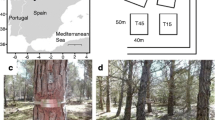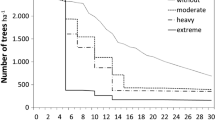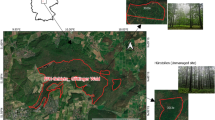Abstract
We assessed the effects of thinning (0, 20 and 30 % extraction of basal area) and canopy type (pine–beech vs. pine plots, beech accounting for 12 % of total basal area) on radial growth of dominant and codominant Scots pine at inter-annual scale and on microclimatic conditions, radial growth and xylogenesis 9 years after thinning at intra-annual scale. Thinning weakly affected pine growth, which was enhanced 3 years after harvesting. Over time, a gradual reduction in pine growth in mixed canopy relative to pure canopy occurred only in unthinned plots apparently due to beech expansion. Indeed, 9 years after thinning, a higher seasonal radial increment and a greater number of tracheids were produced under pine canopy in the unthinned plots, whereas no differences between canopy types were observed in the thinned plots. Radial increment and tracheid production were mainly affected by tree water status (air and soil humidity, throughfall). The differences of tree water status caused by treatments, and plausibly disparities in tree size and tree-to-tree competition, were the main drivers explaining the patterns observed for radial increment and xylogenesis. Our results suggest that the negative effects of beech competition on Scots pine growth in similar mixed forest may be controlled to some extent by thinning.







Similar content being viewed by others
References
Andrew I (1986) Simple experimental design for forestry trials. FRI Bull, vol 71. Forest Research Institute, Roturua
Antonova GF, Stasova VV (1993) Effects of environmental factors on wood formation in Scots pine stems. Trees 7(4):214–219
Antonova GF, Shebeko VV, Malyutina ES (1983) Seasonal dynamics of cambial activity and tracheid differentiation in the stem of Scots pine. Chem Wood 1:16–22
Assman E (1970) The principles of forest yield study. Pergamon Press, Oxford
Aussenac G (2000) Interactions between forest stands and microclimate: ecophysiological aspects and consequences for silviculture. Ann For Sci 57(3):287–301
Blanco JA (2004) La práctica de las claras forestales y su influencia en el ciclo interno de nutrientes en dos bosques de pino silvestre de los Pirineos Navarros. Dissertation, Universidad Pública de Navarra, Pamplona
Blanco JA, Zavala MA, Imbert JB, Castillo FJ (2005) Sustainability of forest management practices: evaluation through a simulation model of nutrient cycling. For Ecol Manag 213:209–228
Bréda N, Granier A, Aussenac G (1995) Effects of thinning on soil and tree water relations, transpiration and growth in an oak forest (Quercus-petraea (Matt) Liebl). Tree Physiol 15(5):295–306
Brix H, Mitchell AK (1980) Effects of thinning and nitrogen fertilization on xylem development in Douglas-fir. Can J For Res 10(2):121–128
Burnham KP, Anderson DR (2002) Model selection and multi-model inference: a practical information-theoretic approach, 2nd edn. Springer, New York
Camarero JJ, Guerrero-Campo J, Gutiérrez E (1998) Tree-ring growth and structure of Pinus uncinata and Pinus sylvestris in the Central Spanish Pyrenees. Arct Alp Res 30(1):1–10
Camarero JJ, Olano JM, Parras A (2010) Plastic bimodal xylogenesis in conifers from continental Mediterranean climates. New Phytol 185(2):471–480
Cescatti A, Piutti E (1998) Silvicultural alternatives, competition regime and sensitivity to climate in a European beech forest. For Ecol Manag 102:213–223
Corcuera L, Camarero JJ, Sisó S, Gil-Pelegrín E (2006) Radial-growth and wood-anatomical changes in overaged Quercus pyrenaica coppice stands: functional responses in a new Mediterranean landscape. Trees 20(1):91–98
Cregg BM, Dougherty PM, Hennessey TC (1988) Growth and wood quality of young loblolly-pine trees in relation to stand density and climatic factors. Can J For Res 18(7):851–858
Curt T, Prevosto B (2003) Rooting strategy of naturally regenerated beech in Silver birch and Scots pine woodlands. Plant Soil 255(1):265–279
Daniels RF, Burkhart HE, Clason TR (1986) A comparison of competition measures for predicting growth of loblolly-pine trees. Can J For Res 16(6):1230–1237
Del Río M, Calma R, Cañellas I, Roig D, Montero G (2008) Thinning intensity and growth response in SW-European Scots pine stands. Ann For Sci 3:308–318
Denne MP (1989) Definition of latewood according to Mork (1928). IAWA Bull 10(1):59–62
Deslauriers A, Morin H (2005) Intra-annual tracheid production in balsam fir stems and the effect of meteorological variables. Trees 19(4):402–408
Deslauriers A, Rossi S, Anfodillo T, Saracino A (2008) Cambial phenology, wood formation and temperature thresholds in two contrasting years at high altitude in southern Italy. Tree Physiol 28(6):863–871
Government of Navarre (2010) Memoria del Mapa de Cultivos y Aprovechamientos de Navarra 1/200.000. Departamento de Agricultura, Ganadería y Alimentación del Gobierno de Navarra, Pamplona
Gracia CA, Sabaté S, Martínez JM, Alveza E (1999) Functional responses to thinning. In: Rodà F, Retana J, Gracia CA, Bellot J (eds) Ecology of Mediterranean evergreen forests. Springer, Berlin, pp 328–329
Granier A, Loustau D, Bréda N (2000) A generic model of forest canopy conductance dependent on climate, soil water availability and leaf area index. Ann For Sci 57(8):755–765
Gruber A, Baumgartner D, Zimmermann J, Oberhuber W (2009) Temporal dynamic of wood formation in Pinus cembra along the alpine treeline ecotone and the effect of climate variables. Trees 23(3):623–635
Gruber A, Strobl S, Veit B, Oberhuber W (2010) Impact of drought on the temporal dynamics of wood formation in Pinus sylvestris. Tree Physiol 30(4):490–501
Holmes RL (1983) Computer-assisted quality control in tree-ring dating and measurement. Tree Ring Bull 43:68–78
Horacek P, Slezingerova J, Gandelova L (1999) Effects of environment on the xylogenesis of Norway Spruce (Picea abies (L.) Kartst.). In: Wimmer R, Vetter RE (eds) Tree-ring analysis: biological, methodological and environmental aspects. CAB International Publishing, New York, pp 33–54
Horn HS (1971) The adaptive geometry of trees, Monographs in population biology, vol 3. Princeton University Press, Princeton
Jaakkola T, Mäkinen H, Sarén MP, Saranpää P (2005) Does thinning intensity affect the tracheid dimensions of Norway spruce? Can J For Res 35(11):2685–2697
Jyske T, Höltta T, Mäkinen H, Nöjd P, Lumme I, Spiecker H (2010) The effect of artificially induced drought on radial increment and wood properties of Norway spruce. Tree Physiol 30(1):103–115
Kelty MJ (1992) Comparative productivity of monocultures and mixed-species stands. In: Kelty MJ, Larson BC, Oliver CD (eds) The ecology and silviculture of mixed-species forests. Kluwer, Dordrecht, pp 125–141
Lagergren F, Lankreijer H, Kucera J, Cienciala E, Molder M, Lindroth A (2008) Thinning effects on pine-spruce forest transpiration in central Sweden. For Ecol Manag 255(7):2312–2323
Larson PR (1994) The vascular cambium, development and structure. Springer, Berlin
Linares JC, Camarero JJ, Carreira JA (2009) Plastic responses of Abies pinsapo xylogenesis to drought and competition. Tree Physiol 29(12):1525–1536
Ma SY, Concilio A, Oakley B, North M, Chen JQ (2010) Spatial variability in microclimate in a mixed-conifer forest before and after thinning and burning treatments. For Ecol Manag 259(5):904–915
Mäkinen H, Isomäki A (2004) Thinning intensity and growth of Scots pine stands in Finland. For Ecol Manag 201:311–325
Mäkinen H, Seo JW, Nöjd P, Schmitt U, Jalkanen R (2008) Seasonal dynamics of wood formation: a comparison between pinning, microcoring and dendrometer measurements. Eur J For Res 127(3):235–245
Martín-Benito D, Del Río M, Heinrich I, Helle G, Cañellas I (2010) Response of climate-growth relationships and water use efficiency to thinning in a Pinus nigra afforestation. For Ecol Manag 259(5):967–975
Morikawa Y, Hattori S, Kiyono Y (1986) Transpiration of a 31-year-old Chamaecyparis obtusa Endl. stand before and after thinning. Tree Physiol 2(1–3):105–114
Mörling T (2002) Evaluation of annual ring width and ring density development following fertilisation and thinning of Scots pine. Ann For Sci 59(1):29–40
Oberhuber W, Gruber A (2010) Climatic influences on intra-annual stem radial increment of Pinus sylvestris (L.) exposed to drought. Trees 24(5):887–898
Oliver CD, Larson BC (1990) Forest stand dynamics. McGraw-Hill, Inc., New York
Pinheiro JC, Bates DM (2000) Mixed-effects models in S and S-PLUS. Statistics and Computing Series. Springer, New York
Piutti E, Cescatti A (1997) A quantitative analysis of the interactions between climatic response and intraspecific competition in European beech. Can J Bot 27:277–284
Pretzsch H (2005) Diversity and productivity in forests: evidence from long-term experimental plots. In: Scherer-Lorenzen M, Körner C, Schulze ED (eds) Forest diversity and function: temperate and boreal systems, ecological studies-analysis and synthesis, vol 176. Springer, Berlin, pp 41–64
Puertas F (2001) Sitios de ensayo de claras de masas de pino silvestre en Navarra, Garde y Aspurz., Pamplona, Navarra, Spain
R Development Core Team (2011) R: a language and environment for statistical computing. R Foundation for Statistical Computing, 2.13.0 edn. R Development Core Team, Vienna
Rambo TR, North MP (2009) Canopy microclimate response to pattern and density of thinning in a Sierra Nevada forest. For Ecol Manag 257:435–442
Rathgeber CBK, Rossi S, Bontemps J-D (2011) Cambial activity related to tree size in a mature silver-fir plantation. Ann Bot 108(3):429–438
Rossi S, Anfodillo T, Menardi R (2006a) Trephor: a new tool for sampling microcores from tree stems. IAWA J 27(1):89–97
Rossi S, Deslauriers A, Anfodillo T, Morin H, Saracino A, Motta R, Borghetti M (2006b) Conifers in cold environments synchronize maximum growth rate of tree-ring formation with day length. New Phytol 170(2):301–310
Schmitt U, Jalkanen R, Eckstein D (2004) Cambium dynamics of Pinus sylvestris and Betula spp. in the northern boreal forest in Finland. Silva Fennica 38(2):167–178
Spiecker H (2003) Silvicultural management in maintaining biodiversity and resistance of forests in Europe-temperate zone. J Environ Manage 67(1):55–65
Vaganov EA, Hughes MK, Shaskin AV (2006) Growth dynamics of conifer tree rings: images of past and future environments. Springer, Berlin
Vesala T, Suni T, Rannik U, Keronen P, Markkanen T, Sevanto S, Gronholm T, Smolander S, Kulmala M, Ilvesniemi H, Ojansuu R, Uotila A, Levula J, Makela A, Pumpanen J, Kolari P, Kulmala L, Altimir N, Berninger F, Nikinmaa E, Hari P (2005) Effect of thinning on surface fluxes in a boreal forest. Glob Biogeochem Cycles 19, GB2001(2)
von Ende CN (2001) Repeated-measures analysis: growth and other time dependent measures. In: Scheiner S, Gurevitch I (eds) The design and analysis of ecological experiments. Oxford University Press, New York, pp 134–157
von Wilpert K (1991) Intraannual variation of radial tracheid diameters as monitor of site specific water stress. Dendrochronol 9:95–113
Yasue K, Funada R, Kobayashi O, Ohtani J (2000) The effects of tracheid dimensions on variations in maximum density of Picea glehnii and relationships to climatic factors. Trees 14(4):223–229
Zuur AF, Ieno EN, Walker N, Saveliev AA, Smith GM (2009) Mixed effects models and extensions in ecology with R. Springer, New York
Zweifel R, Item H, Hasler R (2001) Link between diurnal stem radius changes and tree water relations. Tree Physiol 21(12–13):869–877
Acknowledgments
We thank the GLOBIMED thematic network for making possible the collaboration between the ARAID-IPE and the “UPNA Ecology & Environment Research Group.” The “Departamento de Medio Ambiente” of the Government of Navarre for the experimental setting of silvicultural treatments and, in particular, Fernando Puertas, Carmen Traver and Ana Iriarte and the “Concejo” of Aspurz for permitting the access to the plots. The research has been carried out in the framework of the AGL2006-08288 project (“Ministerio de Economía y Competitividad” of the Spanish Government). I. Primicia was financially supported by the FPI program from the “Ministerio de Economía y Competitividad” of the Spanish Government and the European Social Fund (ESF). J. J. Camarero thanks the support of ARAID. We also thank the two anonymous reviewers for their comments.
Author information
Authors and Affiliations
Corresponding author
Additional information
Communicated by Christian Ammer.
Rights and permissions
About this article
Cite this article
Primicia, I., Camarero, J.J., Imbert, J.B. et al. Effects of thinning and canopy type on growth dynamics of Pinus sylvestris: inter-annual variations and intra-annual interactions with microclimate. Eur J Forest Res 132, 121–135 (2013). https://doi.org/10.1007/s10342-012-0662-1
Received:
Revised:
Accepted:
Published:
Issue Date:
DOI: https://doi.org/10.1007/s10342-012-0662-1




